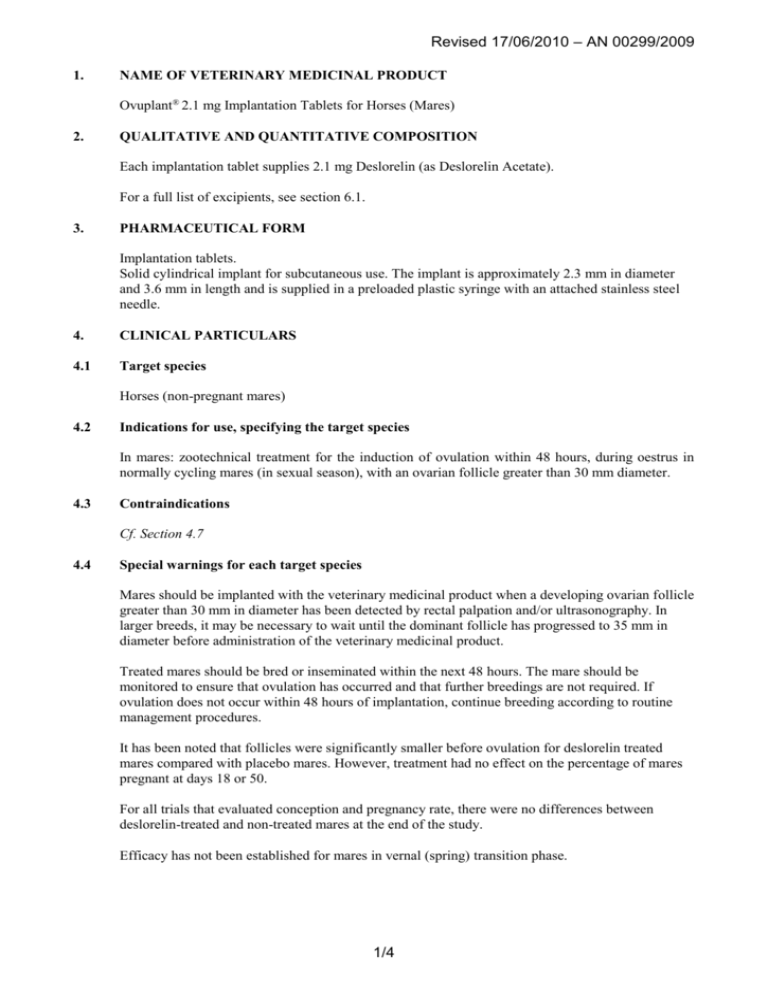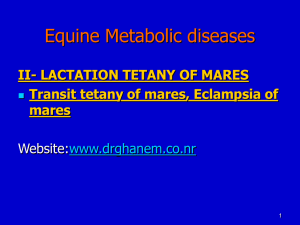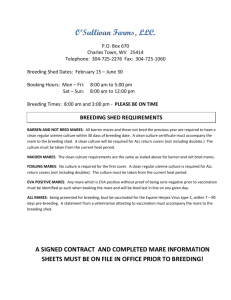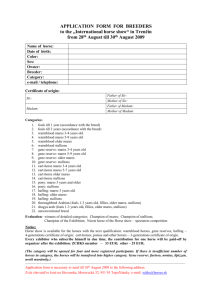Deslorelin is a synthetic oligopeptide analogue of gonadotropin
advertisement

Revised 17/06/2010 – AN 00299/2009 1. NAME OF VETERINARY MEDICINAL PRODUCT Ovuplant® 2.1 mg Implantation Tablets for Horses (Mares) 2. QUALITATIVE AND QUANTITATIVE COMPOSITION Each implantation tablet supplies 2.1 mg Deslorelin (as Deslorelin Acetate). For a full list of excipients, see section 6.1. 3. PHARMACEUTICAL FORM Implantation tablets. Solid cylindrical implant for subcutaneous use. The implant is approximately 2.3 mm in diameter and 3.6 mm in length and is supplied in a preloaded plastic syringe with an attached stainless steel needle. 4. CLINICAL PARTICULARS 4.1 Target species Horses (non-pregnant mares) 4.2 Indications for use, specifying the target species In mares: zootechnical treatment for the induction of ovulation within 48 hours, during oestrus in normally cycling mares (in sexual season), with an ovarian follicle greater than 30 mm diameter. 4.3 Contraindications Cf. Section 4.7 4.4 Special warnings for each target species Mares should be implanted with the veterinary medicinal product when a developing ovarian follicle greater than 30 mm in diameter has been detected by rectal palpation and/or ultrasonography. In larger breeds, it may be necessary to wait until the dominant follicle has progressed to 35 mm in diameter before administration of the veterinary medicinal product. Treated mares should be bred or inseminated within the next 48 hours. The mare should be monitored to ensure that ovulation has occurred and that further breedings are not required. If ovulation does not occur within 48 hours of implantation, continue breeding according to routine management procedures. It has been noted that follicles were significantly smaller before ovulation for deslorelin treated mares compared with placebo mares. However, treatment had no effect on the percentage of mares pregnant at days 18 or 50. For all trials that evaluated conception and pregnancy rate, there were no differences between deslorelin-treated and non-treated mares at the end of the study. Efficacy has not been established for mares in vernal (spring) transition phase. 1/4 Revised 17/06/2010 – AN 00299/2009 4.5 Special precautions for use (i) Special precautions for use in animals Do not use if the foil pouch is broken. Only one implant should be implanted per mare during a given oestrus. The veterinary medicinal product has not been tested in mares less than three (3) years of age. Use only in mares fit for reproduction. (ii) Special precautions to be taken by the person administering the veterinary medicinal product to animals Pregnant women should not administer the veterinary medicinal product as GnRH analogues have been shown to be foetotoxic in laboratory animals. When administering the veterinary medicinal product, take care to avoid accidental self-injection by ensuring that animals are suitably restrained and the application needle is shielded until the moment of implantation. In the case of accidental self-injection, seek medical assistance immediately, with a view to having the implant removed, as GnRH analogues may have adverse effects on the male and female reproductive systems. Although skin contact with the veterinary medicinal product is unlikely, should this occur, wash the exposed area immediately with soap and water, as GnRH analogues may be absorbed through the skin. 4.6 Adverse reactions (frequency and seriousness) Localised swelling and mild fibrosis at the site of implantation has been observed in some mares, accompanied by a slight increase in sensitivity to touch and an elevated skin temperature. These effects are transient and usually resolve without treatment within 2 to 5 days. Some mares implanted with the veterinary medicinal product (deslorelin) may experience an increased dioestrous period following use. 4.7 Use during pregnancy, lactation or lay Do not use during pregnancy. GnRH analogues have been shown to be foetotoxic in laboratory animals when administered during pregnancy. 4.8 Interaction with other medicinal products and other forms of interaction None known. 2/4 Revised 17/06/2010 – AN 00299/2009 4.9 Amounts to be administered and administration route One implant should be administered by subcutaneous implantation in the lateral neck region midway between the head and shoulder. Prepare the implantation site by thoroughly cleaning the skin with an appropriate disinfectant. Insert the entire length of the needle subcutaneously and fully depress the syringe plunger. Slowly withdraw the needle while pressing the skin at the insertion site. Examine the syringe and needle to ascertain that the implant has not remained within the syringe or needle. It may be possible to palpate the implant in situ. The implant is absorbed and does not require removal. Do not attempt to re-use the implanter. 4.10 Overdose (symptoms, emergency procedures, antidotes), if necessary In safety and tolerance studies, the only systemic adverse effect seen in mares receiving up to 10 implants simultaneously was suppression of ovarian activity. 4.11 Withdrawal periods Meat and offal: 7 days. Do not use in mares producing milk for human consumption. 5. PHARMACOLOGICAL PROPERTIES Group: Gonadotropin-releasing hormones ATC vet code: QH01CA93 5.1 Pharmacodynamic properties Deslorelin is a synthetic oligopeptide analogue of gonadotropin releasing hormone used to advance ovulation in oestrus mares. The mechanism of action of deslorelin corresponds with that of naturally occurring GnRH, stimulating the release of follicle stimulating hormone and luteinising hormone (LH) from the pituitary gland. The increased circulating concentration of LH promotes ovulation in mares with a developing follicle greater than 30 mm in diameter. The use of an implant formulation which releases deslorelin over a short time period results in a pre-ovulatory peak of LH within a narrow time frame, thereby inducing ovulation within 48 hours in a high proportion of mares. The advancement of ovulation in this way decreases the duration of oestrus and allows closer synchronisation of mating with ovulation. 5.2 Pharmacokinetic particulars No direct measurement of deslorelin release in vivo has been carried out in the target species. Due to the mode of action and rapid metabolism of deslorelin, direct measurement of the substance in plasma is not practicable. To overcome this, indirect markers of deslorelin have been used by assaying blood concentrations of LH and FSH. The observation of increased LH and FSH concentrations in blood at 12–48 hours after implantation provides indirect evidence that release of deslorelin is occurring. 3/4 Revised 17/06/2010 – AN 00299/2009 6. PHARMACEUTICAL PARTICULARS 6.1 List of excipients Calcium hydrogen phosphate dihydrate Hydrogenated vegetable oil 6.2 Incompatibilities None known. 6.3 Shelf life Shelf life of the veterinary medicinal product as packaged for sale: 2 years. 6.4 Special precautions for storage Store in a refrigerator (2°C - 8°C). 6.5 Nature and contents of immediate packaging The implant is supplied preloaded in a polypropylene syringe with an attached stainless steel needle. Each preloaded implanter is supplied in a sealed foil pouch. 5 of these are packaged in a cardboard carton. 6.6 Special precautions for the disposal of unused veterinary medicinal product or waste materials derived from the use of such products, if appropriate Any unused product or waste materials should be disposed of in accordance with national requirements. 7. MARKETING AUTHORISATION HOLDER Dechra Limited Dechra House Jamage Industrial Estate Talke Pits Stoke-on-Trent Staffordshire ST7 1XW United Kingdom 8. MARKETING AUTHORISATION NUMBER UK: Vm 10434/4063 IE: VPA 10799/017/001 9. DATE OF RENEWAL OF THE AUTHORISATION 14 January 2010 10. DATE OF ANY REVISION OF THE TEXT 17 June 2010 4/4





